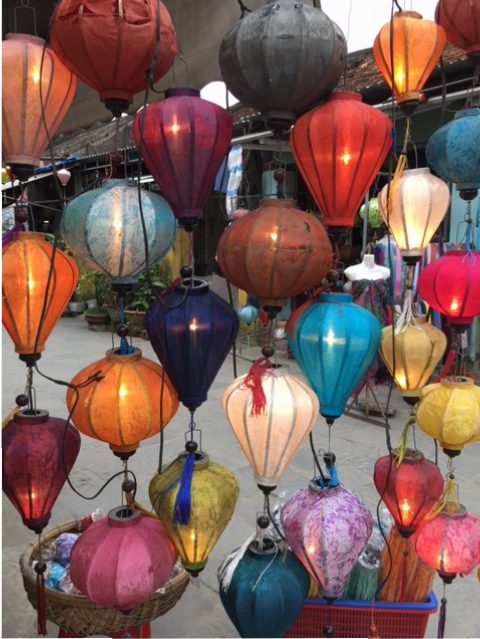
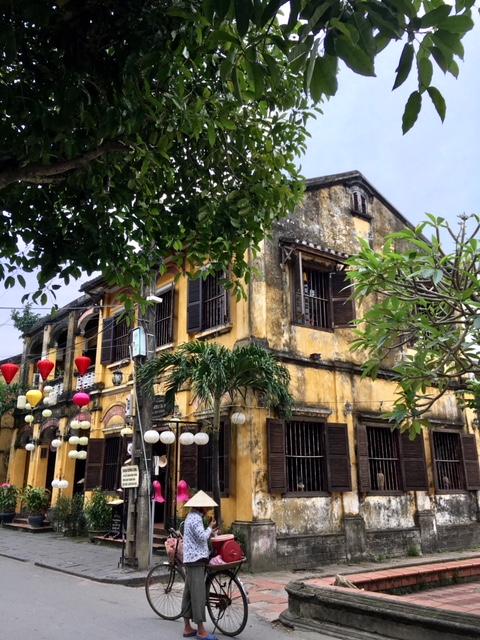
An overnight ride on the Reunification Railway brought me to Ninh Binh from Hue where I’m relaxing in a peaceful inn on a back road in the little village of Tam Coc. The scenery is idyllic and stunning: limestone karsts push high above lush, tropical fruit-filled gardens, while the many lakes, rice paddies and quiet country lanes lined with small, ancient houses, courtyards and coffee houses remind me, for some reason, of southern Italy.
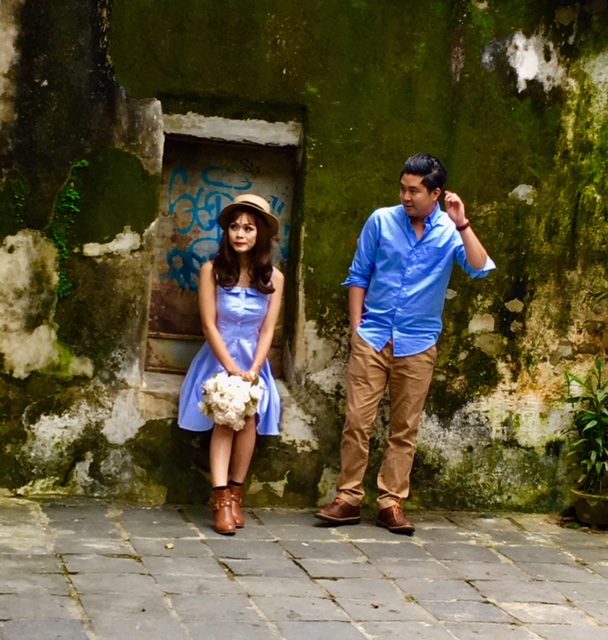
I’m tired, and happy to be someplace peaceful. The Reunification Railway car where I spent the night could use a scrubbing with lye and boiling hot, soapy water and the “white” sheets on my bunk bed looked better in the dark than they did in the daylight. My First Class VIP ticket gave me a bottom berth in a compartment with four “soft-sleeper” beds. Only the other bottom bed was occupied – by a young man who nodded his head curtly to my “hello” before turning his back and inserting his ear buds. Doing my best to get comfortable on the narrow, hard mattress I lay awake for hours, unable to sleep, as the train moved slowly north. The sounds of the train were soothing but the motion was jerky and I was tossed and bounced and thrown against the wall repeatedly. Around 2AM, desperate to pee, I got up and went out to find a bathroom. Between each car there are two cubicles with toilets. The jouncing of the train insures that the seat and floor are well and truely puddled and the tiny space requires one to have the dexterity of a ballet dancer or an acrobat since, to close and/or open the door you have to straddle or climb on top of the commode. All of this while the train lurches and rocks and rolls.
Back in the berth I eventually managed to drift off, waking up briefly at each of the many stops. Just before dawn my roommate left the train in the company of a dozen other young soldiers – at what was clearly an army base – leaving me by myself in the compartment. Relieved to be alone, I ate three, small tangerines, cleaned up as best I could, and, as the sun rose, watched the rice paddies emerge through the mist – workers in their cone hats already bending over the flooded fields.
Young men pushing carts loaded with hot noodles, snacks, coffee and tea, opened my compartment door, asked what I wanted, and handed me a steaming cup of black coffee. By 10:30, after more than 12 hours on the train, I jumped off in Ninh Binh, found my driver who identified himself by showing me my name on his phone, and was driven to Tam Coc and deposited at the Westlake Mountain Homestay where I was greeted by young, beautiful Mrs. Phuong, given a cup of hot tea and ushered into a large room with the best bed I’ve had in SEA. After purusing the town, having an early dinner at The Orchid Cafe, enjoying a good night’s sleep, breakfast, and a climb up a karst to take in the view and see the lovely Dong Pagoda, I’m revived and ready to think back over my action-packed week.
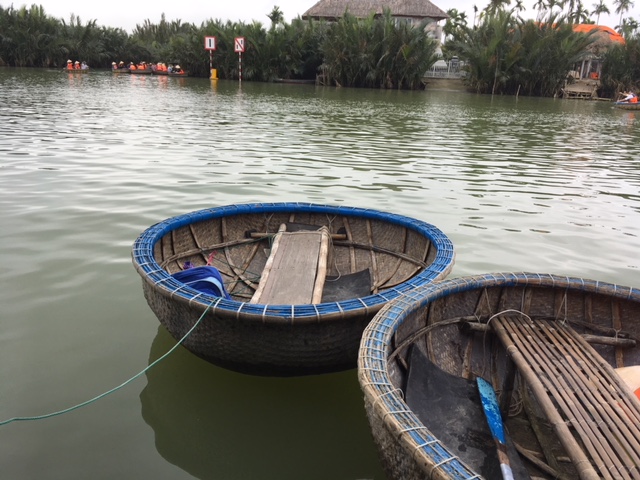
Set in a tiny alley near Old Town, the Dream City Hotel in Hoi An is new, modern, clean, comfortable and run by sweet young things who have been well trained in western tastes. Coming in after being out and about I would be met by one beaming face or another saying, “Hi Nan! How ARE you? I missed you!” It’s completely impossible not to beam back.
When I first arrived in SEA I avoided tourist places. In Vietnam I’m grateful for them. English is spoken, there is understandable signage, restaurants have menus with dishes written in two languages and pictures of the dishes, there are pharmacies of a sort, and mini-marts, and did I mention that English is spoken?! This is the first time I’ve traveled to a part of the world where, with the exception of “Women,” “thank you” and a slowly growing list of food and drink items, I can’t read, speak or understand word one of the language. I didn’t realize how much harder that makes traveling. Thai and Cambodian people speak a lot more English than the Vietnamese, so here it’s only in the major tourist areas that I can actually speak and be spoken to and not have to rely heavily on charades – though I’ve gotten pretty good at that.
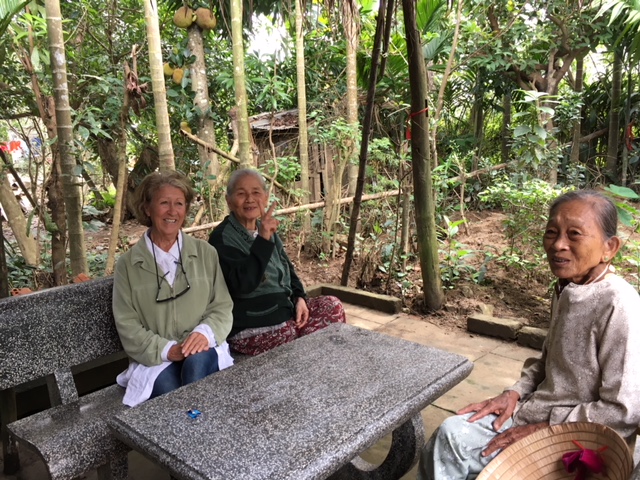
Hoi An sits on the long, wide Thu Bon River which drains into the South China Sea. Since the 15th century, this location as well as the prevailing winds and the abundant treasures of the Orient, made this a premier international port for traders from all over Europe and Asia, and especially from China and Japan. These Asian merchants built settlements here which still exist and the Old Town is a beautiful collection of ancient buildings stretching back from and along the waterfront. Designated a Unesco World Heritage Site in 1999, the city has painstakingly preserved more than 800 old buildings, all painted in the traditional French Colonial ochre color, and is carefully restoring more. The common tangles of wires are being buried, flowering trees and vines flourish and hundreds of beautiful, locally made silk lanterns hang over the lanes. At night their lights look like jewels in the sky. Blessedly, the main streets are off-limit to motorized vehicles, making it easy to walk. The down-side of this beauty, of course, is that it attracts tourists by the thousands and has driven the original inhabitants to the outlying parts of the city.
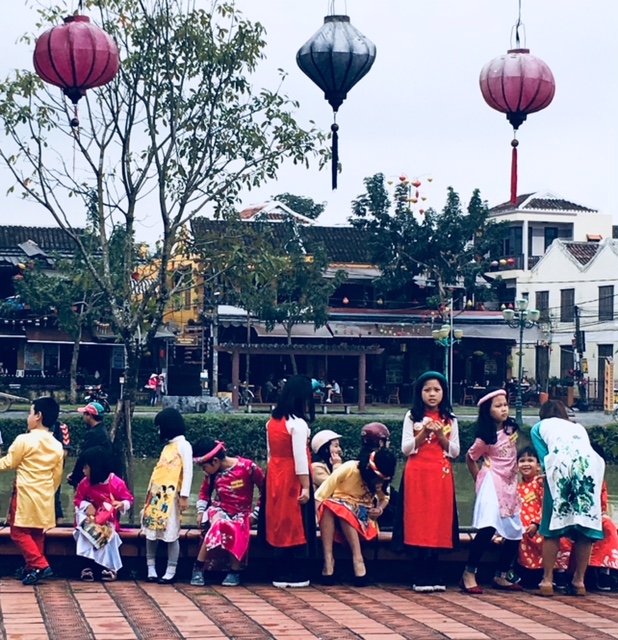
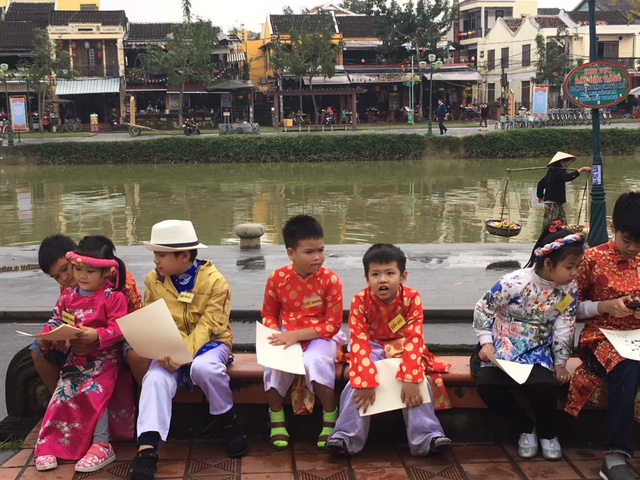
I took two organized tours while I was there: one through Da Nang to the immense Buddha-filled caverns in Marble mountain – and then on to see the great Chinese pagodas, views of the South China Sea and the huge statue of the Lady Buddha on Monkey Mountain – and the next day a seven hour tour on the back of a motor scooter to nearby islands and villages. The scooter tour was a fascinating glimpse of the “real” Hoi An. My driver and guide, Lucy, and her friends Kim and Trung (who drove the couple from L.A. who were also on the tour) were natives of the villages and drove us slowly down the raised, narrow pathways between the bright green rice paddies – weaving around water buffalo and scattering flocks of white egrets – over the many bridges crossing the river and canals and through the twisting lanes of Cam Thanh fishing village, on to Tra Que – an organic farming village – then to Thanh Ha, a pottery-making village, and then to a mat-weaving village and finally through a water coconut plantation. Tea and snacks were offered to us in a home in each village, giving us a chance to meet the artisans, admire their work and learn a bit about their lives. These island villages flood every year, at least once and often a dozen times. The houses are made of plaster-covered brick and are two stories high. When the typhoons rage and the river rises, the water can climb a meter or even two up the walls and everyone retreats to the second floor where they live until the water recedes – using their windows as entrances and exits and their basket boats to get to high ground. When the flood waters go down there is the resultant intense cleanup. And this happens often.
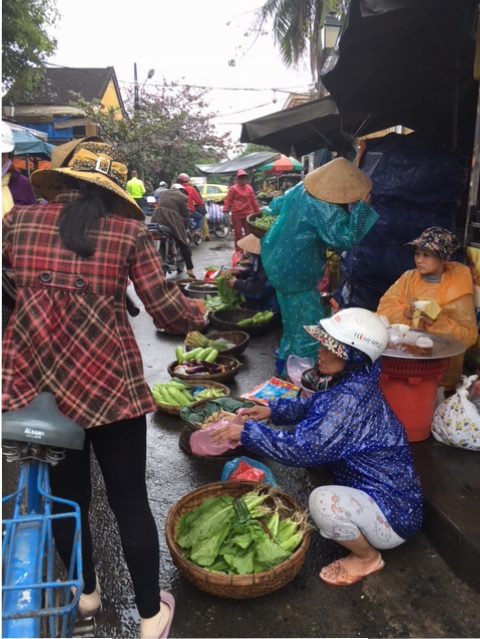
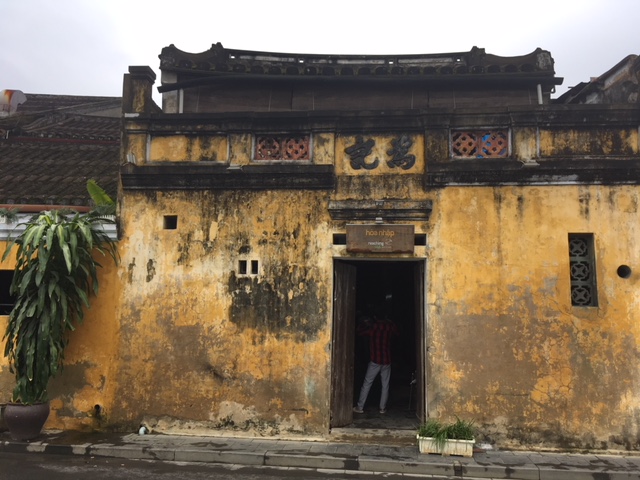
Our last stop was Kim’s home where three generations of her family have made their living making rice noodles for the last fifty years. Her grandmother, now 87, began making rice noodles when she was thirteen. She is an adorable woman, who hugged me and admired my teeth (she has only a few left) and my hair. The old women we met all related to me in the sweetest way, patting my cheeks, holding my hands in theirs, talking non-stop to me. Without one common word we related to each other just fine – though I have never wished more that I could speak the language. I wanted to sit in these tropical gardens with these lovely women for days and hear all their stories.
Kim’s mother, like so many Vietnamese women, works incredibly hard every day of her life. She gets one day off on “Tet Holiday.” The rest of the year she’s up by 2AM to soak, rinse and grind the rice for that day’s product. Restaurant owners start arriving to buy from her at 5AM and families come to shop for their day’s cooking soon after. Trong, a student at Danang University, was the third young man I’ve met to tell me that the women in Vietnam do most of the hard work while the men often sit on the street sipping endless “ca phes” and playing cards. Lucy’s parents are rice farmers and work from before sunrise to sunset, knee-deep in water and mud, bent over from the waist. According to Lucy, the government owns the rice paddies and gives sections to families to farm. How large a section depends upon how many family members there are to work it. The sections are divided by raised mud berms and the fields are criss-crossed with six foot high, packed earth pathways, large and strong enough to support the working water buffalo and the ever-present motorbikes. At harvest time, a percentage of the profit goes to the government. Lucy tells me that she won’t marry – she will stay with her parents and help them rather than moving into her husband’s house to take care of his family. The oldest son in a family is responsible for his parents care and Lucy, her brother, her divorced sister and her 2 year old daughter, live in a small three room house together: the son has his own room which he will share with his wife when he gets married, Lucy shares a room with her sister and niece and the parents sleep in the living room. Divorce, once not possible, is now more common. When I asked if her sister’s ex-husband pays “child support,” she said that he is supposed to but doesn’t.
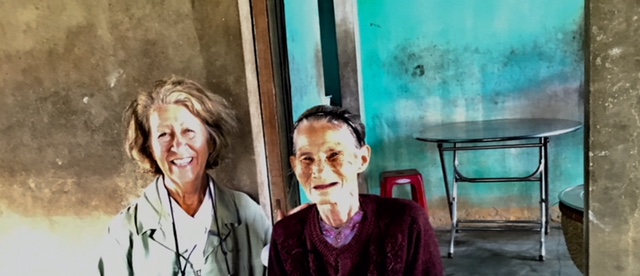
Young men are all required to serve in the military for two years, unless they have severe health problems or don’t meet the height requirements. This must be quite a low bar as the Vietnamese are generally slight of build and short of stature. I have yet to see an over-weight person in SEA: the hard work and the healthy diet – long on vegetables and short on fats, dairy, sugar or processed foods -make it hard to put on extra pounds. I’ve read, though, that in Thailand where KFC, Krispy Kreme and every other western chain has staked a claim, obesity and diabetes are gaining ground.
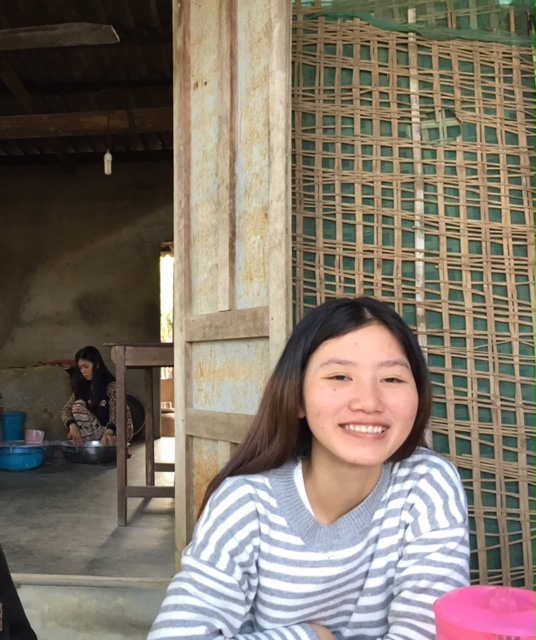
Lucy, Kim and Trong are each the first members of their families to go to university. Learning English, they tell me, is key to success in present-day Vietnam and no matter what the job, if you have passed an English proficiancy exam your chances of being hired are greater than if you haven’t. In the cities students begin learning English in the third grade. In the country, schools begin teaching it in secondary school. The older people may speak French as a second language but the young people are hard at work learning English.
According to USA today, Vietnam has a fast-growing, vibrant economy and hopes and plans to be a “developed” country by 2020. Danny Balo, the young owner of the guest house I stayed in in Can Tho, worries that too much of the “old” Vietnam is being destroyed in it’s furious rush to join the modern world.
Yes, Vietnam is a one-party, authoritarian, officially communist country but it’s founding idealogy appears all but gone from the hearts of the people. “Vietnam, in fact, may actually be one of the most pro-capitalist countries on earth” says Forbes Magazine. Clearly, it is thriving.
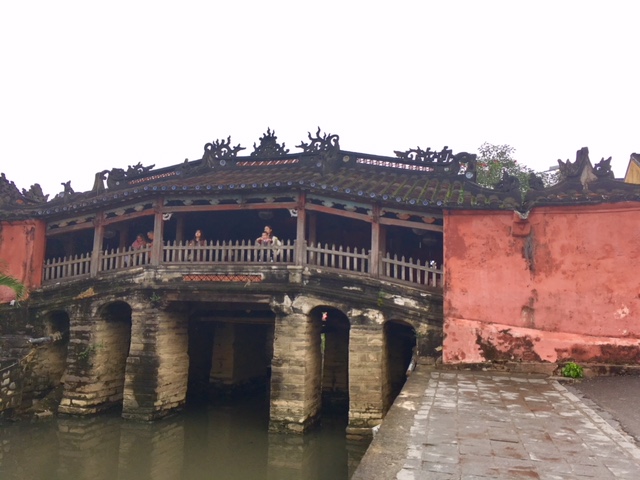

t0q9kv
y3iu4h
ijw8ve
wvigx8
u4h787
6v7d5g
843vbd
4yfq0o
f3kg3x
1h2gwb
tff9l5
4wzkzl
0g574x
l6445g
zxu77h
qhy8zu
t5n78c
ypuzcn
mftgaa
549xc5
lf82zp
klfg6l
rcpcrh
vcldgu
gj2rty
i10kft
fi59yu
zpvn86
a63qvu
lfubui
43h2fu
qp9o5m
cumldk
ee67hm
wfcd39
ey6f17
46ciy2
ybzbga
mvzx3d
l0l5sx